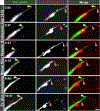The pericyte microenvironment during vascular development
- PMID: 31066166
- PMCID: PMC6834874
- DOI: 10.1111/micc.12554
The pericyte microenvironment during vascular development
Abstract
Vascular pericytes provide critical contributions to the formation and integrity of the blood vessel wall within the microcirculation. Pericytes maintain vascular stability and homeostasis by promoting endothelial cell junctions and depositing extracellular matrix (ECM) components within the vascular basement membrane, among other vital functions. As their importance in sustaining microvessel health within various tissues and organs continues to emerge, so does their role in a number of pathological conditions including cancer, diabetic retinopathy, and neurological disorders. Here, we review vascular pericyte contributions to the development and remodeling of the microcirculation, with a focus on the local microenvironment during these processes. We discuss observations of their earliest involvement in vascular development and essential cues for their recruitment to the remodeling endothelium. Pericyte involvement in the angiogenic sprouting context is also considered with specific attention to crosstalk with endothelial cells such as through signaling regulation and ECM deposition. We also address specific aspects of the collective cell migration and dynamic interactions between pericytes and endothelial cells during angiogenic sprouting. Lastly, we discuss pericyte contributions to mechanisms underlying the transition from active vessel remodeling to the maturation and quiescence phase of vascular development.
Keywords: endothelial cells; pericytes; vascular morphogenesis.
© 2019 John Wiley & Sons Ltd.
Conflict of interest statement
COI Statement: The authors have declared that no conflict of interest exists.
Figures



References
-
- Sims DE, The pericyte--a review. Tissue Cell, 1986. 18(2): p. 153–74. - PubMed
-
- Rouget C, Memoire sur le developpement, la structure et les proprietes physiologiques des capillaires sanguins. Archives Physiol. Normale Pathol, 1873. 5: p. 603–661.
-
- Eberth CJ, Handbuch der-Lehre von den Gewebwn des Menschen und der Tiere 1871. Vol 1(Leipzig: Engelmann; ).
-
- Armulik A, Genove G, and Betsholtz C, Pericytes: developmental, physiological, and pathological perspectives, problems, and promises. Dev Cell, 2011. 21(2): p. 193–215. - PubMed
Publication types
MeSH terms
Grants and funding
LinkOut - more resources
Full Text Sources
Research Materials

